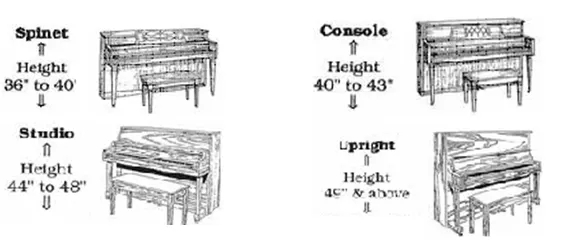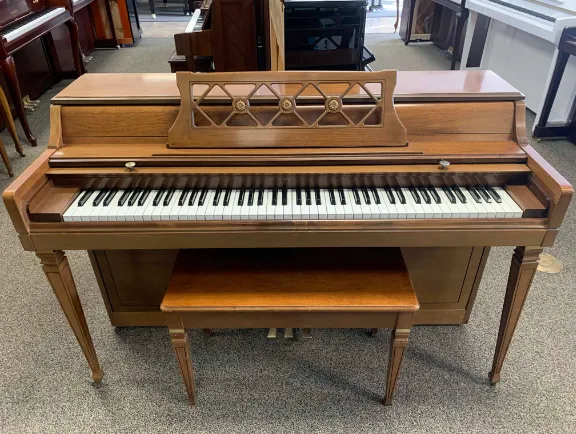Spinet: What is a Spinet Piano vs Upright? 10 ways to know

Is my piano a spinet?
There are all sorts of different size pianos with different make and models out there, but how do you tell if yours is a spinet within a couple of minutes?
There are grand pianos, baby grand pianos, vertical pianos, console pianos, continental pianos, and spinet pianos, but what makes a spinet so much different that they are singled out from the rest?
Perhaps you’re asking because you’ve realized that many piano tuners in your area place them in a separate category of “historical” pianos or they refuse and even loathe to work on compared with modern pianos.
Let’s talk about why that is while learning the distinct differences of what makes a piano a spinet.
Here are 10 Major signs your piano is a spinet
#1 How tall is a spinet?
The height of this type of piano is the shortest of all old uprights, which makes for a small soundboard and short string length.
Being generally around 38 inches high the instrument necessarily has shorter strings and a smaller sound.
These small pianos often sound insubstantial due to the short length of the strings and small soundboards.
#2 If the name says Wurlitzer or Acrosonic
Chances are if there are one of these two names on the front of the piano and it does not look like a grand piano, it is likely to be a spinet.
Baldwin’s Acrosonic Spinet is a classic example of one of the most popular spinets ever produced in the United States beginning in the late 1930’s.
The feel of the action is toy-like and is more like a smaller version of a piano than a great option for learning how to play the piano.
The other extremely popular spinet was the Wurlitzer spinet which will say Wurlitzer on the front of the fall board.
These two brands of spinets were some of the most popular pianos that now reside in homes in the United States collecting dust.
#3 Music Shelf height
If the music shelf protrudes well above the top of the lid at the top of the piano, then chances are that your piano is a spinet.
As a result of the piano taking up such limited space, the music stand will stand more than half the height of the stand taller than the cabinet itself.
This is the last of the visually easy way to tell that your piano is a spinet before having to take it apart or having sufficient know-how about how a good piano plays differently.
#4 Drop Action
What is a drop action?
Since spinets are very short it requires them to have a drop action inside of the piano which allows all of the parts to be contained within such a condensed space.
Admittedly for its small size, it is impressive how it can fit an entire piano action within its tiny cabinet.
If you are to look inside of the cabinet you will see that the back of the keys have drop down “stickers” that hang off the back and transfer motion to the action.
This action can also be referred to as an indirect blow action.
The position of the action is directly behind and beneath the keys, which if you think about it, is quite a clever and compact action design.
In a regular piano the inside of the cabinet contains a full size action which take up more space and do not contain long drop down wires that transfer motion almost a foot away to reach the bottom of the action.
#5 How they compare to modern pianos
One of the most obvious differences a piano teacher will notice about modern pianos is their unquestionably better performance.
Not only do they perform better, but they sound better because of the longer strings and larger soundboard.
We all know that a concert grand will sound and perform better than smaller pianos, but even console pianos that are the next size larger have better form and function than spinets due to the slightly taller size of the instruments.
#6 Decorative Cabinets
These pianos are kept by many folks because of the charm the piano keeps in the living room.
At the end of the day it is all a matter of personal preference in the aesthetic value that spinet pianos offer to those who refuse to give them up or trade them in.
Even some old pianos have decorative cases that give it its own charm, spinets do provide a decorative charm for the small amount of space it takes up, after all, it is a whole piano sitting there!
#7 Inherent limitations
If you’ve been playing on a spinet then you know that the shorter keys make it impossible to play medium difficult pieces excellently.
These pianos have a different feel to them than larger upright pianos, which make them feel like a toy, rather than a professional upright piano.
The different kind of action makes it difficult to play a challenging music composition.
#8 It has been with your family since the great depression
Spinets were a popular choice back in the Great Depression when they first emerged because the market desired its smaller size and smaller cost.
During and after that time, the Baldwin Acrosonic boasts that it was the most sold model piano ever made!
#9 Tuners will be reluctant to work on them
Why won’t the piano tuner work on my spinet?
Many qualified piano technician’s will refuse to work on this type of piano because the time and effort spent will not result in a satisfactory outcome.
Often the tonal quality is poor and the tuning itself is questionable even after it is tuned to the best ability of talented tuners.
#10 It never really sounds in tune
Why does the piano not sound good even after it was tuned?
Often, spinet pianos never really sound very good due to size, age, and quality of the materials used.
A good quality piano will tune up much better than a spinet piano and for much longer.
The main difference between a spinet piano and any other types of uprights comes down to size.
For at home pianists, hobby players, music schools, and professional musicians, just about any modern piano will surpass every aspect of the spinet piano.
Telling the difference between a regular piano and a spinet will be much easier to identify after reviewing this list.
Thank you for reading!











